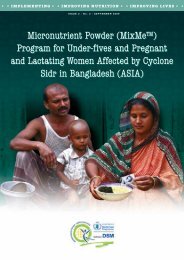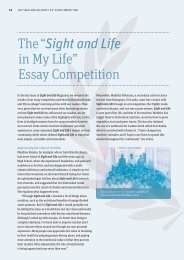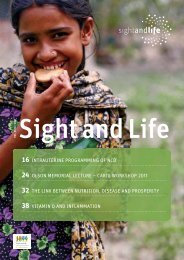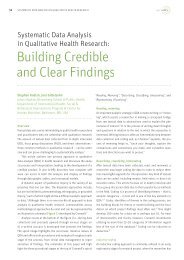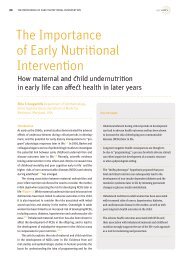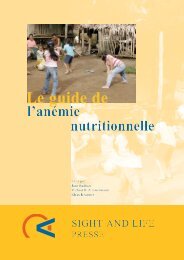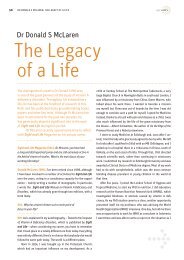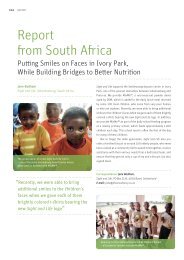26 THE IMPORTANCE OF VITAMIN Afigure 8: Retinol <strong>and</strong> RBP in plasma before <strong>and</strong> after inhalation of retinyl palmitate (Biesalski et al., 1999) 6422Normal range RBPRetinol [μmol/L]1Normal range RetinolRBP [μmol/L]10Pre-inhalationPost-inhalation0Pre-inh.Post-inhalationWhole population (n =161)Study group (n =25)Placebo group (n =25)Study groupPlacebo groupInhalation of vitamin A improves vitamin A status in Ethiopian children with severe fat malabsorptionmay serve as an alternative method for vitamin A therapy duringchronic or acute episodes of malnutrition, malabsorption or inthe case of insufficient compliance with other therapies, <strong>and</strong> itmight be useful in treating respiratory diseases associated withvitamin A deficiency.“Delivery of retinyl palmitate byinhalation is effective in improvingvitamin A status”It should be investigated to what extent the “topical” applicationof retinyl esters on the respiratory epithelium, especiallyin those with chronic lung disease of prematurity, can contributeto the replenishment of lung stores <strong>and</strong> thus lead to an improvedclinical outcome.ConclusionThe results cited show that retinyl esters in respiratory epithelium<strong>and</strong> in alveolar cells form a pool of vitamin A, which can beused physiologically by the tissue. The formation of retinol <strong>and</strong>,subsequently, retinoic acid from retinyl esters is strictly controlled.So far, unphysiological formation of retinoic acid <strong>and</strong> subsequenttoxicity do not seem possible. Retinyl esters, however, arebiochemically inert with respect to gene expression or vitamin Aactivity as long as they are not hydrolyzed. Consequently, inhalativeapplication, especially in cases of insufficient lung development,could represent a true alternative. Oral administration ishardly successful because of poor RBP synthesis by the liver, <strong>and</strong>a parenteral solution is currently not available.To ensure sufficient ante- <strong>and</strong> postnatal lung maturation, acontinuous adequate supply of vitamin A is important before<strong>and</strong> during pregnancy. The vicious cycle of poor vitamin A statusin pregnancy <strong>and</strong> the consequently poor status of the newborn<strong>and</strong> the consequences for further development including adulthood<strong>and</strong> pregnancy needs to be interrupted. If no fortified foodwith preformed vitamin A is available, -carotene sources eitherfrom green leafy vegetables <strong>and</strong> fruit or biofortified food (e.g.maize, sweet potatoes) represent an alternative to improve thevitamin A supply. In cases of an “emergency” approach, supplementswith high doses either before pregnancy or in the finalterm may be useful, but data are inconsistent. A future approachwhich might help to overcome poor vitamin A status with impairedlung function is the inhalation of retinyl esters.Despite conflicting results from intervention studies, due todifferent study protocols <strong>and</strong> dosages, there can be no doubt thatthe adequate vitamin A statuses of mother <strong>and</strong> newborn have agreat impact on outcome <strong>and</strong>, in particular, the lung function ofthe newborn <strong>and</strong> the mortality <strong>and</strong> morbidity of both mother <strong>and</strong>child. It is therefore of great importance to harmonize differentsupplementation protocols to develop useful <strong>and</strong> effective recommendationsfor vitamin A delivery at the different stages ofpregnancy, as well as the antenatal <strong>and</strong> postnatal periods.
SIGHT AND LIFE | VOL. 25 (1) | <strong>2011</strong> THE IMPORTANCE OF VITAMIN A 2727Correspondence: Hans-Konrad Biesalski, University ofHohenheim, Institute 140, Fruwirthstrasse 12, 70593 Stuttgart,Germany E-mail: biesal@uni-hohenheim.deReferences01. Kurokowa R, DiRenzo J, Boehm M et al. Regulation of retinoidsignalling by receptor polarity <strong>and</strong> allosteric control of lig<strong>and</strong>binding. Nature 1994; 371:528–531.02. Morree DM: Intracellular actions of vitamin A. In Jeon KW, ed.Friedl<strong>and</strong>er: International review of cytology. San Diego:Academic Press, 1992; 1–31.03. Pinnock CB, Douglas RM, Badcock NR. Vitamin a status in childrenwho are prone to respiratory tract infections. Aust Paediatr J 1986;22:95–99.04. Sommer A. Vitamin A supplementation <strong>and</strong> childhood morbidity.Lancet 1993; 342:1420–1224.05. West KP, Pokhrel RP, Katz J et al. Efficacy of vitamin A in reducingpreschool child mortality in Nepal. Lancet 1991; 338:67–71.06. Zachman RD. Retinol (vitamin A) <strong>and</strong> the neonate: specialproblems of the human premature infant. Am J Clin Nutr 1989;50:413–424.07. Metzler MD, Snyder JM. Retinoic acid differentially regulatesexpression of surfactant-associated proteins in human fetal lung.Endocrinology 1993; 133:1990–1998.08. Weaver TE, Whitsett JA. Function <strong>and</strong> regulation of expressionof pulmonary surfactant-associated proteins. Biochem J 1991;273:249–264.09. Odom MJ, Snyder JM, Boggaram V. Glucocorticoid regulationof the major surfactant associated protein (SP-A) <strong>and</strong> itsmessenger ribonucleic acid <strong>and</strong> of morphological development ofhuman fetal lung in vitro. Endocrinology 1988; 123:1712–1720.10. Allred TF, Mercer RR, Thomas RF et al. Brief 95% O2 exposureeffects on surfactant protein <strong>and</strong> mRNA in rat alveolar <strong>and</strong>bronchiolar epithelium. Am J Physiol. 1999;276:L999–L100911. Sundell HW, Gray ME, Serenius FS et al. Effects of epidermalgrowth factor on lung maturation in fetal lambs.Am J Pathol 1980; 100:707–725.12. Oberg KC, Carpenter G. EGF-induced PGE2 release is synergisticallyenhanced in retinoic acid treated fetal rat lung cells. BiochemBiophys Res Commun. 1989 ;162(3):1515–2113. Maden M, Hind M. Retinoic acid in alveolar development,maintenance <strong>and</strong> regeneration. Philos Trans R Soc Lond B Biol Sci.2004; 29;359:799–808.14. Bl<strong>and</strong> RD, Albertine KH, Pierce RA et al. Impaired alveolardevelopment <strong>and</strong> abnormal lung elastin in preterm lambs withchronic lung injury: potential benefits of retinol treatment. BiolNeonate. 2003;84:101–2.15. Geevarghese SK, Chytil F. Depletion of retinyl esters in the lungscoincides with lung prenatal morphological maturation. BiochemBiophys Res Commun 1994; 200:529–535.16. Massaro D, Massaro GD. Toward therapeutic pulmonary alveolarregeneration in humans. Proc Am Thorac Soc.3: 709-712 200617. Massaro D, Massaro GD. Lung development, lung function, <strong>and</strong>retinoids. N Engl J Med. 2010; 362(19):1829-31 (8):709-1218. Checkley W, West KP Jr, Wise RA et al. Maternal vitamin Asupplementation <strong>and</strong> lung function in offspring. N Engl J Med.2010;362:1784–9419. Grune T, Lietz G, Palou A et al. Beta-carotene is an importantvitamin A source for humans. J Nutr. 2010 Dec;140(12):2268S–2285S.20. Leung WC, Hessel S, Méplan C et al. Two common singlenucleotide polymorphisms in the gene encoding beta-carotene15,15'-monoxygenase alter beta-carotene metabolism in femalevolunteers. FASEB J. 2009;23(4):1041–521. Shenai JP., Chytil F. Vitamin A stores in the lungs during perinataldevelopment in the rat. Biol. Neonate. 1990; 57: 126–13222. Biesalski HK. Separation of retinyl esters <strong>and</strong> their geometricisomers by isocratic adsorption high-performance liquidchromatography. Methods Enzymol. 1990;189:181–9.23. Dirami G, Massaro GD, Clerch LB et al. Lung retinol storing cellssynthesize <strong>and</strong> secrete retinoic acid, an inducer of alveolus formation.Am J Physiol Lung Cell Mol Physiol. 2004;286(2):L249–5624. Isakson BE, Lubman RL, Seedorf GJ et al. Modulation of pulmonaryalveolar type II cell phenotype <strong>and</strong> communication by extracellularmatrix <strong>and</strong> KGF. Am.J.Cell.Physiol. 2001; 281: C1291–C129925. Gottesman ME, Quadro L, Blaner WS. Studies of vitamin A metabolismin mouse model systems. Bioessays 2001; 23: 409–41926. Blomhoff R, Green RH, Berg T et al. Transport <strong>and</strong> storage of vitaminA. Science 1990; 250:399–40427. Theodosiou M., Laudet V, Schubert M. From Carrot to clinic:an overview of the retinoic acid signaling pathway. Cell Mol <strong>Life</strong> Sci.2010; 67:1423–144528. Ross AC, Ambalavanan N. Retinoic acid combined with vitaminA synergizes to increase retinyl ester storage in the lungs ofnewborn <strong>and</strong> dexamethasone-treated neonatal rats. Neonatology.2007;92:26–32.29. Ambalavanan N, Tyson JE, Kennedy KA et al. National Institute ofChild Health <strong>and</strong> Human Development Neonatal Research Network.Vitamin A supplementation for extremely low birth weight infants:outcome at 18 to 22 months. Pediatrics. 2005;115:249–54.⇢



